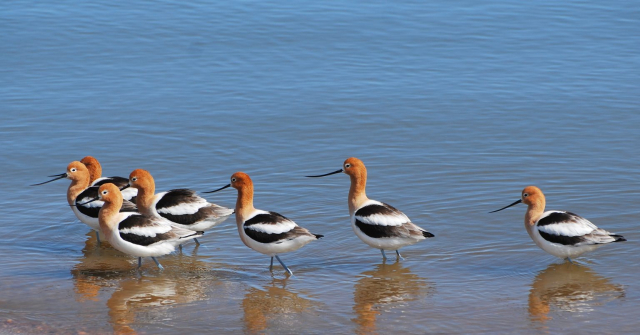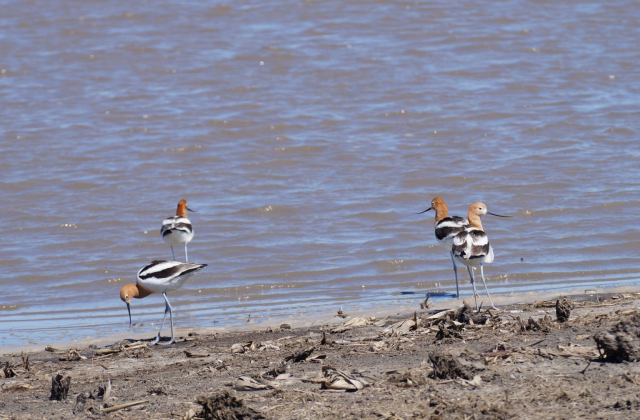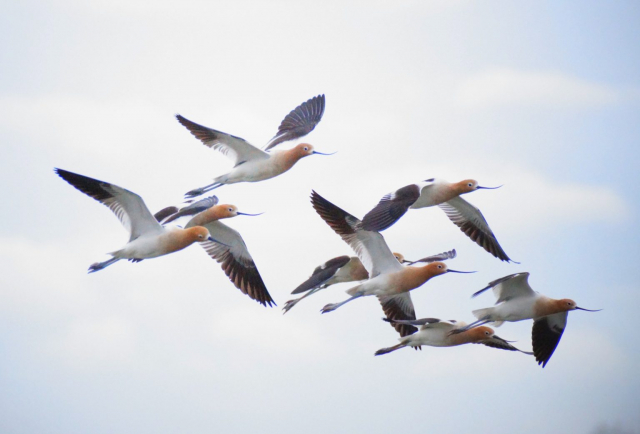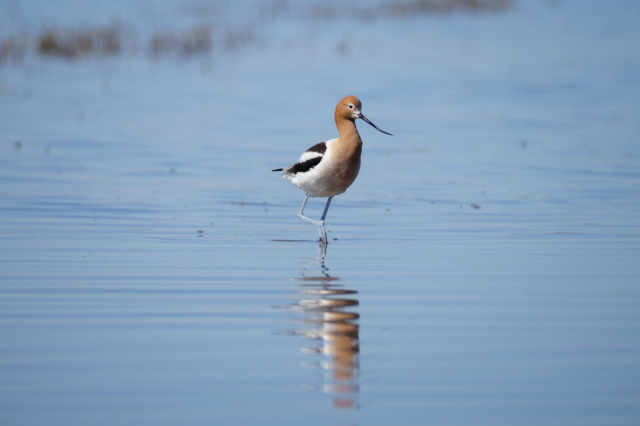Recurvirostra americana
Status: Common regular spring and fall migrant west and central, fairly common east. Uncommon, locally common, regular breeder west and north, rare casual elsewhere. Rare casual summer visitor away from breeding locations.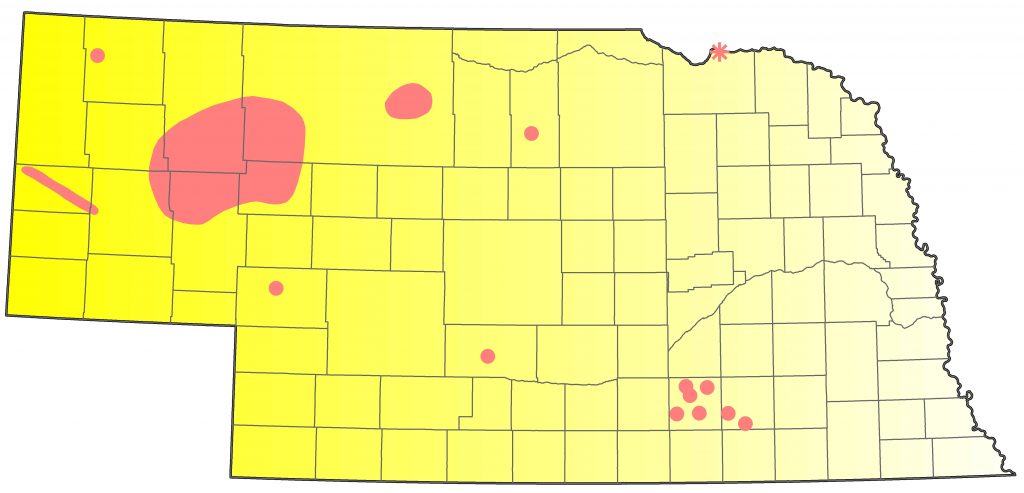
Documentation: Specimen: UNSM ZM6614, 17 Jun 1902 Clear Lake, Cherry Co.
Taxonomy: No subspecies are recognized (AviList 2025).
Spring: Mar 29, 30, 30 <<<>>> summer
An earlier date is 18 Mar 2017 Sheridan Co.
Migrants arrive in early to mid-Apr and peak numbers occur at the end of Apr. Migrants, or possibly immature non-breeders, linger into Jun and early Jul; mid-Jun through early Jul reports away from the Sandhills are of one at LaPlatte Bottoms, Sarpy Co 13-17 Jun 2020, up to three a few miles northwest of Grand Island, Hall Co 13 Jun-7 Jul 2020, one near Wallace, Lincoln Co 15 Jun 2021, 19 Jun 1988 Pierce Co, 25 Jun 2024 Buffalo Co, and singles in Lancaster Co 27 Jun 2020, 27 Jun 2024, and 1 Jul 2025.
High counts: 600-700 near Niobrara, Knox Co 25 Apr 2013, 480 at Lakes North and Babcock, Platte Co 19 Apr 2025, 354 in the eastern Rainwater Basin (including 106 at a Seward Co location) 30 Apr 2010, and 303 in Sarpy Co 30 Apr 2010.
Summer: This species breeds regularly in the western Sandhills east to Cherry Co in the north (Ducey 1988) and westward at least to Scotts Bluff and Dawes Cos; there were 45 nests at Crescent Lake NWR, Garden Co 9 Jun 2007. In Scotts Bluff Co breeding occurs regularly at Kiowa WMA; at least three pairs produced young in 2003 and seven broods were noted in 2004. At Mansfield Marsh, Dawes Co, 12 adults with at least two chicks were present 13 Jun 1998.
There are several nesting reports in areas adjacent to this core range. A nest at Lake McConaughy, Keith Co 19 Jun 2017, when 42 adults were present, was the first known nesting record there. Two or three pairs were nesting at a cattle feedlot pond near Darr, Dawson Co 2 and 5 Jul 2009. The easternmost nesting in the north occurs on artificial islands at the west end of Lewis and Clark Lake, Knox Co, that were constructed to provide nesting habitat for Piping Plovers and Least Terns. Nesting was first noted there in 2007 (one nest) and subsequently in 2012 (two nests), 2013 (four nests) and 2014 (one nest) (K. Hunt, personal communication). A nest with four eggs was photographed at Twin Lakes WMA, Rock Co 22 Jun 2016.
There are a few nesting records from the Rainwater Basin but breeding success has been elusive. Two nests and young were reported in Phelps Co in 1974 (Bennett 1975) and nesting was “confirmed” at Clay Co sites during 1984-89 (Mollhoff 2001, Jorgensen 2012) and 2006-2011 (Mollhoff 2016, Jorgensen 2012). Two pairs at Harvard WPA, Clay Co 30 May 2005 had one nest but no eggs; three pairs were nesting there 3 Jun 2008. Two nests, each with four eggs, were at Hultine WPA, Clay Co 31 May 2008, but these were apparently unsuccessful (Jorgensen 2012). Copulation was observed at Trumbull Basin, Clay Co 3 May 2010. In 2019, an exceptionally wet summer, there were three breeding attempts, but all failed (Jorgensen and Brenner 2019). Two nests photographed at Sora WMA, Fillmore Co 18 May 2019 were the first for Fillmore Co, but, unfortunately, heavy rains flooded the nests about a week afterwards. Another nest was photographed on private property approximately a mile north of Mallard Haven WPA, also in Fillmore Co, on 13 Jun 2019 but was unsuccessful. Two nests with eggs on private property approximately a mile south of Harvard WPA, Clay Co on 19 Jun 2019 may have been unsuccessful also; the wetland had dried up by 24 Jul with no avocets present.
Elsewhere, in the east and south, summer (Jun-Jul) reports are few, most along the Platte River and nearby counties.
- Breeding Phenology:
Copulation: 2 May 2002
Eggs/Incubation: 15 May- 14 Jul (Mollhoff 2022)
Young: 25 May- 4 Jul.
- High counts: 270 at Crescent Lake NWR 16 Jul 1996 (Grzybowski 1996), 150 at Lakeside, Sheridan Co 29 Jul 2022, and 81 east of Alliance in Sheridan Co 14 Jul 2024.
Fall: summer <<<>>> Nov 8, 8, 8
Migrants away from breeding areas are evident in early and mid Jul: singles were at Harlan Co Reservoir, Harlan Co and near Orleans, Harlan Co, both on 6 Jul 2000, nine at Scottsbluff SL, Scotts Bluff Co 7 Jul 2016, and one in Sarpy Co 13 Jul 2014. Peak numbers occur in mid-Sep.
There are later reports 10 Nov 2010 (6) Lancaster Co, 11 Nov 2023 (4) Harlan Co, 11 Nov 2023 Buffalo Co, 13 Nov 2013 (20) Sheridan Co, and one at Lake McConaughy 28 Nov and 5 Dec 1998, possibly an injured bird.
- High counts: 1100 in the western Sandhills 5 Sep 2012 (including 654 at one location), 1020 in Sheridan Co 21 Sep 2014, 645 at Lakeside, Sheridan Co 23 Sep 2013, and 643 there 16 Sep 2007.
Images
Abbreviations
SL: Sewage Lagoons
UNSM: University of Nebraska State Museum
WMA: Wildlife Management Area (State)
WPA: Waterfowl Production Area (Federal)
Literature Cited
AviList Core Team, 2025. AviList: The Global Avian Checklist, v2025. https://doi.org/10.2173/avilist.v2025.
Bennett, E.V. 1975. 1974 Nebraska nesting survey. NBR 43: 13-19.
Ducey, J.E. 1988. Nebraska birds, breeding status and distribution. Simmons-Boardman Books, Omaha, Nebraska, USA.
Jorgensen, J.G. 2012. Birds of the Rainwater Basin, Nebraska. Nebraska Game and Parks Commission, Lincoln, Nebraska, USA.
Jorgensen, J.G., and S.J. Brenner. 2019. Notable avian nesting records from the Rainwater Basin, Nebraska — 2019. Nongame Bird Program of the Nebraska Game and Parks Commission, Lincoln, Nebraska, USA
Mollhoff, W.J. 2001. The Nebraska Breeding Bird Atlas 1984-1989. Nebraska Ornithologists’ Union Occasional Papers No. 7. Nebraska Game and Parks Commission, Lincoln, Nebraska, USA.
Mollhoff, W.J. 2016. The Second Nebraska Breeding Bird Atlas. Bull. Univ. Nebraska State Museum Vol 29. University of Nebraska State Museum, Lincoln, Nebraska, USA.
Mollhoff, W.J. 2022. Nest records of Nebraska birds. Nebraska Ornithologists’ Union Occasional Paper Number 9.
Recommended Citation
Silcock, W.R., and J.G. Jorgensen. 2025. American Avocet (Recurvirostra americana). In Birds of Nebraska — Online. www.BirdsofNebraska.org
Birds of Nebraska – Online
Updated 2 Sep 2025
